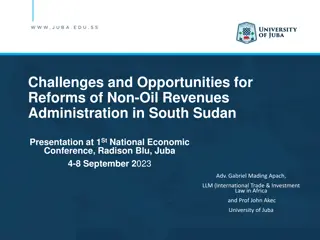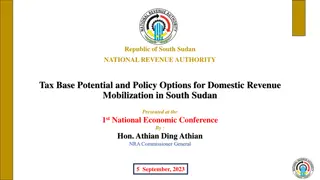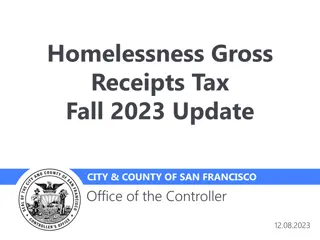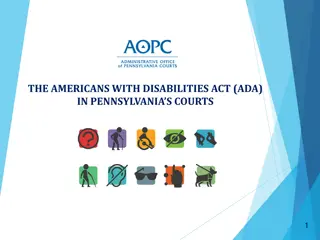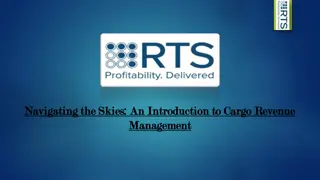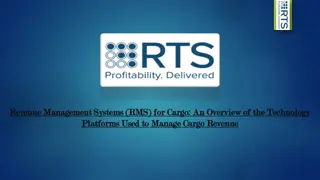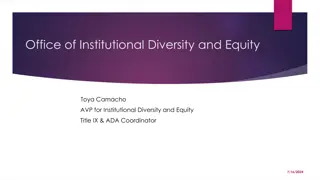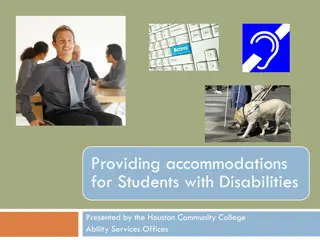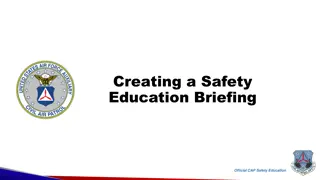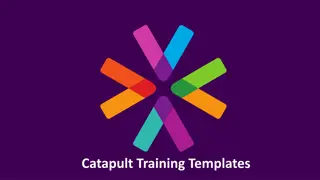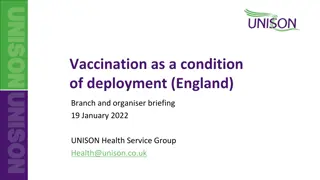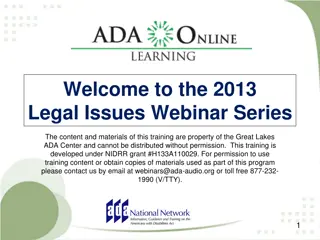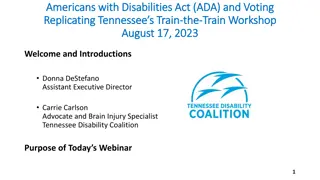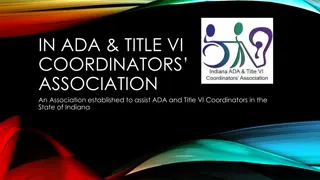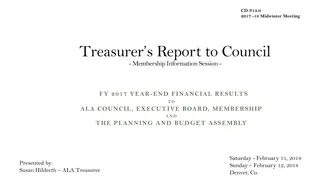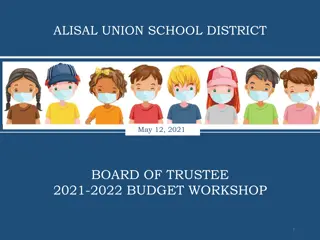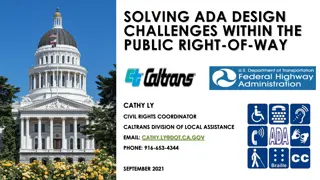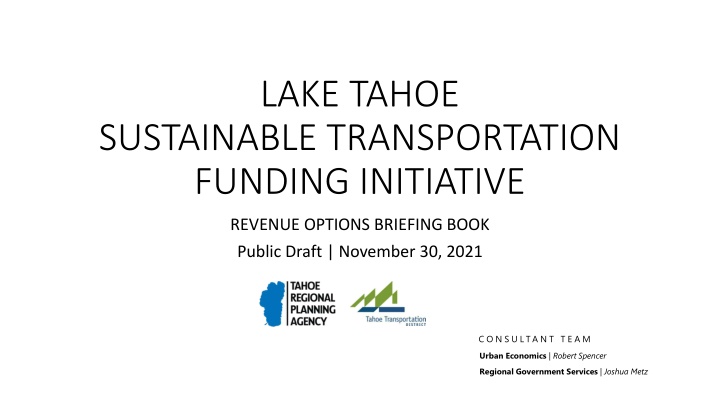
Sustainable Transportation Funding at Lake Tahoe: Revenue Options Briefing
This briefing book supports decision-makers in the Lake Tahoe Basin with transportation funding policy decisions. It covers planning, regional projects, policy drivers, revenue evaluation, and options. The goal is to secure sustainable funding to enhance transit operations and maintenance while leveraging funding from various sectors. The report emphasizes the need for new funding sources to support the region's transportation goals.
Download Presentation

Please find below an Image/Link to download the presentation.
The content on the website is provided AS IS for your information and personal use only. It may not be sold, licensed, or shared on other websites without obtaining consent from the author. If you encounter any issues during the download, it is possible that the publisher has removed the file from their server.
You are allowed to download the files provided on this website for personal or commercial use, subject to the condition that they are used lawfully. All files are the property of their respective owners.
The content on the website is provided AS IS for your information and personal use only. It may not be sold, licensed, or shared on other websites without obtaining consent from the author.
E N D
Presentation Transcript
LAKE TAHOE SUSTAINABLE TRANSPORTATION FUNDING INITIATIVE REVENUE OPTIONS BRIEFING BOOK Public Draft | November 30, 2021 C O N S U LTA N T T E A M Urban Economics | Robert Spencer Regional Government Services | Joshua Metz
Table of Contents Tahoe Basin Transportation Planning ............................................. Regional Transportation Projects .. Sustainable Transportation Funding Initiative Policy Drivers .. Revenue Evaluation .. Revenue Option Descriptions Next Steps 4 9 13 21 26 47
INTRODUCTION The purpose of this briefing book is to support Lake Tahoe Basin decision makers in arriving at sound transportation funding policy decisions. This briefing book is supported by a Revenue Options Report that can be found at: https://www.trpa.gov/transportation/funding/sustainable-funding-initiative/ New sustainable regional transportation funding is needed to (1) leverage funding from other sectors, and (2) support basin-wide transit system operations and maintenance. This briefing report is organized into the following sections: Tahoe Basin transportation planning; Regional transportation projects; Sustainable transportation funding initiative policy drivers; Revenue evaluation; Revenue options description; Next steps.
SECTION 1 TAHOE BASIN TRANSPORTATION PLANNING
Bi-State Consultation on Transportation In 2017, the states of California and Nevada convened a Bi-State Consultation on Transportation to work with public and private partners on ways to accelerate transportation improvements at Lake Tahoe. The consultation created a Transportation Action Plan that identifies top-priority projects and services. Following the direction from the Bi-State Consultation, TRPA and TTD have continued to engage partners to identify and recommend new funding sources to generate a minimum of $20 million annually to deliver improvements to meet regional goals. Initial findings suggest that contributions from all sectors (federal, state, local, and private) may be needed to fill this minimum target for new funding.
Regional Transportation Plan (RTP) Millions of visitors from outside the Region, primarily seasonal tourism and outdoor recreation, drives the Region s $5 billion annual economy. Visitor flows put metropolitan- level travel demands on the Region s limited and largely rural transportation system. During peak times of visitation, Tahoe s roads clog with traffic and parking demands exceed capacity at recreation sites. This seasonal influx of motorists has consequences for the air and water quality, for local communities and their mobility, and for the visitor experience. The RTP is adopted every four years by the Tahoe Regional Planning Agency (TRPA), providing a funding plan and identifying priority transportation improvements over a multi- decade planning horizon to address these challenges. The recently adopted RTP for the Tahoe Basin articulates a vision for Tahoe s transportation system to meet goals for mobility, environmental sustainability, and economic vitality. The vision is for a system that is interconnected, inter-regional, and sustainable, connecting people and places in ways that reduce reliance on the private automobile.
Regional Transportation System Consensus There is broad consensus within the region that to meet growing travel demand a transportation system transformation is needed to: Improve transportation system efficiency: Help people travel to, from, and around the Region more efficiently. Expanding transportation options to conserve and restore Tahoe s environment: Enable transit, bicycle, and pedestrian options and multi-modal services to compete with and reduce auto travel, thereby (1) protecting the Basin s sensitive natural environment, especially the Lake, and (2) supporting federal, state & regional policy objectives to reduce greenhouse gas emissions and build a resilient system in response to climate change. Strengthen other initiatives: Strengthen initiatives underway to revitalize communities, improve quality of life for residents and quality of experience for visitors, and improve mobility and safety for people walking and biking, and improve recreation access and sustainability.
Regional Transportation Plan Goals & Vision Mobility Inter-Regional Sustainability Economic Vitality Interconnected
SECTION 2 REGIONAL TRANSPORTATION PROJECTS
Regional Priority Projects Regional priority projects were identified through collaboration with the Bi-State Consultation on Transportation, TRPA, TTD, and local governments. State Route 89 Emerald Bay Corridor The corridor management plan call for Emerald bay shuttles every 15 minutes, parking management, new trails, and other infrastructure improvements New Regional Funding: $15 million Total Project Cost: $60 million State Route 28 Stateline-to-Stateline Corridor Infrastructure investments are needed to advance the trail along the entire East Shore linking Incline Village to Spooner Summit. Parking and safety enhancements, pedestrian crossings, and a link to Spoon Front Country facilities are needed. New Regional Funding: $18 million Total Project Cost: $80 million U.S. 50 South Stateline Community Revitalization Reclaiming a main street along U.S. Highway 50 will make the heart of the South Shore more walkable, bikeable, and economically viable while protecting Lake Tahoe s spectacular environment. New Regional Funding: $56 million Total Project Cost: $156 million Placer Resort Triangle Priority Transit Lanes Placer County is leading this new innovative project to dedicate transit lanes on State Routes 89 and 267 during peak travel times to reduce congestion and improve traffic flow and safety. New Regional Funding: $20 million Total Project Cost: $410 million
Illustrative RTP Projects: Transit Transit investments are needed to improve service to the local community and the millions of visitors to Lake Tahoe. By growing public-private partnerships on transit, Lake Tahoe will benefit from reduced congestion and greenhouse gas emissions. Key Projects: Free local transit and new transit routes to recreation hot spots New Regional Funding: $207 million Other Funding: $502 million Total Project Cost: $709 million
Illustrative RTP Projects: Trails The Tahoe Region has a growing system of shared-use paths, sidewalks, bicycle lanes, crosswalks, and accessible facilities. The network is critical to increasing trips by foot and bike in the region. Key Projects: Resort Triangle Bikeway Network, Pioneer Trail Sidewalks, and the South Tahoe Greenway network. New Regional Funding: $36 million Other Funding: $5 million Total Project Cost: $41 million
Illustrative RTP Projects: Communities and Corridors Enhancing our communities to provide travel options for workforce, local trips, and visitors that connect town centers, recreation, housing, and jobs. Key Projects: Corridor revitalization, complete street projects, and safety improvements. New Regional Funding: $20 million Other Funding: $12 million Total Project Cost: $32 million
Illustrative RTP Projects: Operations and Maintenance Continued investment in operations and maintenance ensures the transportation system functions at a high level and reduces the impact from emission and stormwater runoff on Lake Tahoe. Key Projects: Closing the funding gap on maintaining local roads, existing trails, and new complete streets projects. New Regional Funding: $24 million Other Funding: $24 million Total Project Cost: $48 million
SECTION 3 SUSTAINABLE TRANSPORTATION FUNDING INITIATIVE POLICY DRIVERS
Current RTP & State Policy Drivers for New Funding There are three current RTP and state policies driving the need for the region to identify new sustainable transportation revenue: RTP minimum target for new regional funding; Nevada Senate Concurrent Resolution 8; TRPA vehicle miles traveled threshold.
Policy Driver #1: Regional Funding Target To deliver the RTP, the Tahoe region needs new sustainable regional transportation funding. The new regional funding target shown below represents the minimum target of $20 million annually in ongoing new funding ($400 million over 20 years). Project Area New Regional Funding Target This table summarizes areas of investment for the minimum regional funding target of $400 million over the next 20 years. Additional detail and illustrative projects are included later in this document and found in the 2020 Regional Transportation Plan. These amounts do not reflect other leveraged funding sources needed. Regional Priorities $109 million Transit $207 million Trails $36 million Communities & Corridors $20 million Operations & Maintenance $24 million Accountability $4 million Total $400 million
RTP Average Annual Funding by Sector PRIVATE: $4.1M - 4% LOCAL: $20.2M- 21% FEDERAL: $26.6M - 28% No regional revenue sources currently exist. Meeting this target is the focus of this Briefing Book. REGIONAL Minimum Funding Target: $19.4M - 20% STATE: $26.5M - 27%
Policy Driver #1: Regional Funding Target Continued The lack of regional funding makes the Basin more dependent on state and federal sources compared to other regions. Given the Basin s transportation priorities, revenue options that address the minimum target for new funding need to focus on funding that is highly fungible , that is, applicable to a variety of uses and most importantly: As a match to leverage funding from other sectors and secure the balance of funding necessary to fully fund projects, and For transit operations and maintenance (as opposed to transit capital projects) that other regions primarily fund with regional revenue because transit O&M gets only limited support from state and federal sources.
Policy Driver #2: Nevada Senate Concurrent Resolution 8 The Director of the Nevada State Department of Conservation and Natural Resources and the Secretary of the California Natural Resources Agency have been convening a Bi-State Consultation on Transportation consisting of persons representing state, local, regional and federal governmental agencies, business groups, the environmental community and the resort and tourism industries to help identify appropriate solutions to meet the Lake Tahoe Basin s unique and complex transportation challenges. The Nevada Senate has requested that the Bi-state Consultation identify priority transportation projects and potential recommendations for funding those projects in the Lake Tahoe Basin (Nevada Senate Concurrent Resolution 8 (2021)).
Policy Driver #3: TRPA Vehicle Miles Traveled (VMT) Threshold The TRPA has recently adopted a revised vehicle miles traveled (VMT) threshold. Achievement of that threshold requires a reduction in annual daily average VMT per capita by 6.8 percent by 2045. Successful implementation will require full funding of the RTP. The RTP includes a funding policy (Policy 5.4) to collaborate with local, state, tribal, regional, federal, and private partners to develop a regional revenue source to fund Lake Tahoe transportation investments . TRPA has committed to implementing Policy 5.4 to demonstrate support for the revised VMT threshold with the following management actions: By December 31, 2021: submit a proposal for dedicated sources of transportation funding to the California and Nevada Legislatures supported by the Bi-State Consultation. By December 31, 2023: begin collection of ongoing regional revenue source(s) dedicated to transportation in the Tahoe Basin that is reasonably expected to meet the $20 million average annual minimum target for new regional funding for the RTP.
Other Issues Affecting Revenue Options Three other significant issues affect the selection of revenue options: Visitor impacts: The large impact of visitors suggests the need to identify revenue options directly related to visitor activity. Existing local funding: Local jurisdictions dedicate substantial transient occupancy tax funds to transportation and have recently approved significant new transportation funding ($1.1M annually from North Lake Tahoe Tourism and Business Improvement District (TBID), and $2.1M annually from the City of South Lake Tahoe sales tax measure for road repair). Complex governance: The Basin s complex governance structure requires the consensus of local and state government as well as private stakeholders to implement a successful funding strategy.
SECTION 4 REVENUE OPTIONS EVALUTION
Revenue Options Revenue options were identified to address the identified minimum $20M per year minimum regional funding target. This effort is the result of extensive stakeholder engagement initiated during the summer of 2021. This report analyzes 19 revenue options for sustainable transportation funding in the Basin. Revenue options included in this report met the following criteria: Analyzed in the One Tahoe effort mentioned above (that report included 24 revenue options and was the primary source of revenue options for this report); Identified through research conducted for this report; Likely not to require amendment to the California or Nevada constitutions; Likely not to require federal legislation.
Revenue Options Evaluation Criteria The stakeholder engagement process included a survey to identify revenue option evaluation criteria. Final implementation will not include those that require congressional action or have constitutional conflicts. Based on the survey, the following six criteria received the most responses from those surveyed: Fungible (any use): is funding flexible, particularly for transit services and as a local match for state and federal grants? Fungible (basin-wide): can funding be used throughout the Basin? Equity (by income): does the funding burden fall disproportionately on lower income households as a percent of income or otherwise inhibit access to destinations in the Basin? Equity (visitors/residents): do day and overnight visitors contribute funding proportionate to their impacts on the transportation system? Sustainable: will funding provide a reasonably predictable and constant funding stream, can bonds be issued, and is funding significant enough to assist in achieving the minimum funding target (greater than $1M annually against the $20M minimum target)? Transparent: is funding transparent as a transportation revenue source to those who pay and could funding provide a pricing strategy for a more efficient use of the transportation system?
REVENUE OPTIONS EVALUATION Equity (Visitor/Resi dent) Fungible (Any Use) Fungible (Basin-wide) Equity (Income) Transparent Sustainable LOCAL L1. Sales Tax L2. Transient Occupancy Tax met met not met not met not met met outcome uncertain not met not met not met not met met met L3. Property Transfer Tax met not met not met not met met REGIONAL R1. Sales Tax R2. Transient Occupancy Tax met met met met not met met outcome uncertain met not met not met not met not met met not met not met not met not met met met R3. Real Property Transfer Tax met not met not met not met met R4. Vacancy Tax R5. Basin Entry Fee R6. Zonal Fee R7. Parking Fees R8. Mobility Fee R9. Rental Car Mitigation Fee met not met not met met met met met not met not met met met met met met met met met met not met met met met not met not met met met met met not met not met Evaluation Criteria: met, not met, or outcome uncertain PRIVATE outcome uncertain outcome uncertain P1. Commuter Transit Subsidies not met met not met not met STATE S1. CA & NV Funding Formula S2. CA Budget Surplus S3. CA Existing Grants S4. CA New Grant Programs S5. NV Bonds FEDERAL F1. Transportation Act: Formula F2. Transportation Act: Grants not met not met not met not met not met not met not met not met not met not met met not met not met not met not met not met met not met not met not met met met met met met met not met not met not met not met not met not met not met not met met met not met not met met met met not met
REVENUE OPTIONS POTENTIAL Sector Revenue Options Jurisdiction Avg Annual Amount (M)1 $23.9 $9.5 $7.0 $6.3 $5.8 $4.7 $4.7 $2.9 $2.9 $2.3 $1.7 $1.6 $1.1 $1.0 $1.0 $0.9 $0.8 $0.8 $0.7 $0.6 $0.5 $0.4 $0.4 $0.4 $0.2 $0.1 $0.1 <$0.1 TBD Tax/Fee Rate % Funding Target3 123% 49% 36% 33% 30% 24% 24% 15% 15% 12% 9% 8% 6% 5% 5% 4% 4% 4% 3% 3% 3% 2% 2% 2% 1% <1% <1% <1% TBD Regional Regional Regional Regional Federal Regional Regional State State Local Federal Local Local Local State Local Regional Local Local Local Local Local Regional State Local Regional Local State Private R5. Basin Entry Fee R6. Zonal Fee R7. Parking Fees R4. Vacancy Tax F2. Transportation Act: Grants R1. Sales Tax (basin-wide) R2. Transient Occupancy Tax S1. CA & NV Funding Formula S3. CA Existing Grants L1. Sales Tax F1. Transportation Act: Formula L2. Transient Occupancy Tax L1. Sales Tax L2. Transient Occupancy Tax S4. CA New Grant Programs L2. Transient Occupancy Tax R3. Real Property Transfer Tax L1. Sales Tax L2. Transient Occupancy Tax L3. Real Property Transfer Tax L2. Transient Occupancy Tax L1. Sales Tax R8. Mobility Mitigation Fee S5. NV Bonds L3. Real Property Transfer Tax R9. Rental Car Mitigation Fee L1. Sales Tax S2. CA Budget Surplus P1.Commuter Transit Subsidies $4.00 per vehicle3 $10.00 per vehicle4 $10.00 per vehicle $250 per vacant housing unit $5M initially (2023) Basin-wide Basin-wide 0.5% of taxable sales 1.0% of lodging sales $3M initially (2026) $3M initially (2026) City of SLT 0.5% of taxable sales $1.5M initially (2023) City of SLT Placer Douglas 1.0% of lodging sales 0.5% of taxable sales 1.0% of lodging sales $1M initially (2026) Placer Basin-wide Washoe El Dorado Washoe Washoe Douglas 1.0% of lodging sales $1.00 per $1,000 of real property sales 0.5% of taxable sales 1.0% of lodging sales $1.00 per $1,000 of real property sales 1.0% of lodging sales 0.5% of taxable sales $0.3M initially (2022) $10M one-time (2026) Douglas $1.00 per $1,000 of real property sales $5.50 per car per day El Dorado 0.5% of taxable sales $2M one-time (2022) TBD 1 Revenue estimates ($M=million) assume two percent annual inflation increase from initial year and calculate annual average by dividing by 25 years (2021-2045) regardless of initial year. 2 RTP minimum regional funding target is $485.9 million, or $19,400,000 annually over 25 years. 3Basin entry fee assumes payment by visitors only and exempts residents and commuters. 4 Zonal fee assumes payment only by vehicles stopping in zone, not vehicles driving through zone.
SECTION 5 REVENUE OPTION DESCRIPTIONS
Avg Annual Amount %RTP Funding Gap LOCAL: Sales Tax Tax/Fee Rate Jurisdiction 0.5% of retail sales Placer $1.1M 6% Additional sales tax increment within the Basin by jurisdiction. 0.5% of retail sales CA: Legislature gives each county separate authority to create special tax district (City of SLT already has authority), district (or City) seeks 2/3 voter approval. City of SLT $3.2M 16% 0.5% of retail sales El Dorado $0.1M <1% NV: Legislature directly authorizes tax for each County within Basin with 2/3 legislature approval. 0.5% of retail sales Washoe $0.9M 6% 0.5% of retail sales Douglas $0.5M 4% Pros: Fungible (any use): May be used for any transportation purpose. Sustainable: Reasonably predictable and bondable and generates significant funding for most jurisdictions. Cons: Fungible (basin-wide): Limited to jurisdiction-related projects/services. Equity (by income): Lower income households pay more as percent of income. Equity (visitors/residents): Captures limited funding from day visitors relative to impact. Transparent: Not transparent as a transportation funding source to those paying. Other: Using North Tahoe TBID approach basin-wide (assessing taxable and non-taxable sales) would increase revenue by 65% or more above the estimates in this table. Implementation: Consider including Resort Triangle area in Placer County tax area and funding agreements with the Town of Truckee.
LOCAL: Transient Occupancy Tax Avg Annual Amount %RTP Funding Gap Jurisdiction Tax/Fee Rate Additional TOT increment within the Basin by jurisdiction. 1.0% of lodging sales Requires 2/3 voter approval within each jurisdiction s area within the Basin. Placer $900K 4% 1.0% of lodging sales City of SLT $1.6M 8% 1.0% of lodging sales El Dorado $0.7 3% 1.0% of lodging sales Washoe $500K 3% Pros: 1.0% of lodging sales Douglas $1M 5% Fungible (any use): May be used for any transportation purpose. Equity (by income): Households spend similar percent of income on lodging. Sustainable: Reasonably predictable and bondable and generates significant funding for most jurisdictions. Cons: Fungible (basin-wide): Limited to jurisdiction-related projects/services. Equity (visitors/residents): Captures funding from overnight visitors but not from day visitors relative to impact. Transparent: Not transparent as a transportation funding source to those paying. Other: Implementation: Consider including Resort Triangle area in Placer County tax area and funding agreements with the Town of Truckee.
LOCAL: Real Property Transfer Tax %RTP Funding Gap Additional real property transfer tax within the Basin by jurisdiction. Avg Annual Amount Jurisdiction Tax/Fee Rate CA: Prohibited by Proposition 13 in California (only charter cities can increase RPTT). Placer NA $1 per $1,000 of real property sales NA El Dorado NA $1 per $1,000 of real property sales NA NV: Legislature directly authorizes tax with 2/3 legislature approval for each jurisdiction. City of SLT NA $1 per $1,000 of real property sales NA Washoe $600K $1 per $1,000 of real property sales 3% Douglas $200K $1 per $1,000 of real property sales 1% Pros: Fungible (any use): May be used for any transportation purpose. Sustainable: Reasonably predictable and bondable and generates significant funding for most jurisdictions. Cons: Fungible (basin-wide): Limited to jurisdiction-related projects/services. Equity (visitors/residents): Captures limited funding from day visitors relative to impact. Transparent: Not transparent as a transportation funding source to those paying. Other: Equity (by income): No data available. Using North Tahoe TBID approach basin-wide (assessing taxable and non-taxable sales) would increase revenue by 65% or more above the estimates in this table. Implementation: Consider including Resort Triangle area in Placer County tax area and funding agreements with the Town of Truckee.
REGIONAL: Sales Tax Avg Annual Amount %RTP Funding Gap 24% Additional sales tax increment within the Basin basin-wide Tax Rate 0.5% $4.7M TTD adopts additional sales tax increment within the Basin. Requires 2/3 voter approval per Bistate Compact, Article IX. Pros: Fungible (by use): May be used for any transportation purpose. Fungible (basin-wide): May be used throughout the Basin. Sustainable: Reasonably predictable and bondable and generates significant revenue. Cons: Equity (by income): Lower income households pay more as percent of income. Equity (visitors/residents): Captures limited funding from day visitors relative to impact. Transparent: Not transparent as a transportation funding source to those paying. Other: Implementation: Consider using existing dormant Placer County special tax district and integrating Resort Triangle and Town of Truckee into funding and project programming.
REGIONAL: Transient Occupancy Tax Additional TOT increment within the Basin basin-wide. Avg Annual Amount %RTP Funding Gap 24% Tax Rate 1.0% $4.7M Requires 2/3 voter approval per Bistate Compact, Article IX. Pros: Fungible (by use): May be used for any transportation purpose. Fungible (basin-wide): May be used throughout the Basin. Equity (by income): Households spend similar percent of income on lodging. Sustainable: Reasonably predictable and bondable and generates significant revenue. Cons: Equity (visitors/residents): Captures funding from overnight visitors but not from day visitors relative to impact. Transparent: Not transparent as a transportation funding source to those paying. Other: Implementation: Consider integrating Resort Triangle area and Town of Truckee into funding and project programming.
REGIONAL: Real Property Transfer Tax %RTP Funding Gap Additional tax on real property sales within the Nevada portion of the Basin. Avg Annual Amount Jurisdiction Tax/Fee Rate CA: Prohibited by Proposition 13 in California (only charter cities can increase RPTT). Placer NA $1 per $1,000 of real property sales NA El Dorado NA $1 per $1,000 of real property sales NA NV: Legislature directly authorizes tax with 2/3 legislature approval for each jurisdiction. City of SLT NA $1 per $1,000 of real property sales NA Washoe $600K $1 per $1,000 of real property sales 3% Douglas $200K $1 per $1,000 of real property sales 1% Pros: Fungible (any use): May be used for any transportation purpose. Sustainable: Reasonably predictable and bondable and generates significant funding for most jurisdictions. Cons: Fungible (basin-wide): Limited to use in NV portion of Basin. Equity (visitors/residents): Does not capture funding from day or overnight visitors. Transparent: Not transparent as a transportation funding source to those paying. Other: Equity (by income): No data to evaluate. Existing funding: Existing tax rates in Nevada jurisdictions about 4x higher than in CA jurisdictions ($3.90 to $4.00 versus $1.10 per $1,000). This type of funding has a more direct nexus to funding affordable housing, another critical issue for the Basin, than to transportation.
REGIONAL: Vacancy Tax Tax Rate per Housing Unit $250 Avg Annual Amount $6.3M %RTP Funding Gap 33% Tax on single family housing units including condominiums that are not the permanent residence of the owner. TTD places tax measure on ballot. Requires 2/3 voter approval. Pros: Fungible (any use): May be used for any transportation purpose. Fungible (basin-wide): May be used throughout the Basin. Equity (by income): Higher income households more likely to be second homeowners. Equity (visitors/residents): Capture funding from overnight but not day visitors. Sustainable: Reasonably predictable and bondable and generates significant revenue. Cons: Transparent: Not transparent as a transportation funding source to those paying. Other: Vacancy tax is typically adopted to incentivize use of vacant property to increase housing supply. Vancouver and Oakland have vacancy taxes; Los Angeles and San Francisco considering them. Implementation: Consider integrating Resort Triangle area and Town of Truckee into funding and project programming.
REGIONAL: Basin Entry Transportation User Fee Fee paid by roadway transportation users entering the Basin (fee could vary by peak vs. off-peak periods). Avg Annual Amount $23.9M 123% %RTP Funding Gap Fee Rate $4 CA & NV legislatures amend Bistate Compact, Article IX, and approved by 2/3 of Basin voters. Pros: Equity (visitors/residents): Captures funding from day and overnight visitors. Sustainable: Reasonably predictable and bondable and generates significant revenue. Transparent: Transparent as a transportation funding source to those paying. Cons: Fungible (basin-wide): CA revenue may be used basin-wide. NV revenue limited to use on NV public highways (NV Const. Article IX, Section 5). Fungible (by use): In CA may be used for any transportation purpose. In NV constrained to the construction, maintenance, and repair of the public highways (NV Const. Article IX, Section 5). Equity (by income): Lower income households pay more as percent of income. Other: Funding increased transit service would mitigate negative impacts on equity (by income). The public typically does not pay for transportation services through this type of fee.
REGIONAL: Zonal Transportation User Fee Fee paid by visitors stopping in two high recreation use zones: Hwy. 28 and Hwy. 89/Emerald Bay corridors (fee could vary by peak vs. off-peak periods). Avg Annual Amount $9.5M %RTP Funding Gap 49% Fee Rate $10 CA & NV legislatures amend Bistate Compact, Article IX, and approved by 2/3 of Basin voters. Pros: Equity (visitors/residents): Captures funding from day and overnight visitors. Sustainable: Reasonably predictable and bondable and generates significant revenue. Transparent: Transparent as a transportation funding source to those paying. Cons: Fungible (basin-wide): CA revenue may be used basin-wide. NV revenue limited to use on NV public highways (NV Const. Article IX, Section 5). Fungible (by use): In CA may be used for any transportation purpose. In NV constrained to the construction, maintenance, and repair of the public highways (NV Const. Article IX, Section 5). Equity (by income): Lower income households pay more as percent of income. Other: Funding increased transit service would mitigate negative impacts on equity (by income). The public typically does not pay for transportation services through this type of fee.
REGIONAL: Parking Fees Avg Annual Amount $7.0M %RTP Funding Gap 36% Fee for parking in off-street lots serving recreation sites Fee Rate $10 Tahoe Transportation District authorizes in cooperation with state and federal partners. If funding greater than parking management and related costs (e.g., for transit), requires 2/3 voter approval in CA, and may need NV state legislation. Pros: Fungible (by use): May be used for any transportation purpose. Fungible (basin-wide): May be used throughout the Basin. Equity (visitors/residents): Captures funding from day and overnight visitors. Sustainable: Reasonably predictable and bondable and generates significant revenue. Transparent: Transparent as a transportation funding source to those paying. Cons: Equity (by income): Lower income households pay more as percent of income. Depending on fee rate, revenue may not cover needs beyond operations and maintenance of parking lots. Other: Funding increased transit service would mitigate negative impacts on equity (by income). Use electronic payment systems at each parking lot and/or sell parking passes online and through local retailers.
REGIONAL: Mobility Fee Projects creating new VMT within the Basin (formerly air quality mitigation fee). Avg Annual Amount %RTP Funding Gap 2% Fee Rate 2x current $0.4M Tahoe Regional Planning Agency authorize, adopts revised fee through ordinance. Pros: Fungible (by use): May be used for any transportation purpose. Fungible (basin-wide): May be used throughout the Basin. Equity (visitors/residents): Captures funding from day and overnight visitors. Cons: Equity (by income): No data to evaluate. Sustainable: Not predictable or bondable but does generate significant revenue. Transparent: Not transparent as a transportation funding source to those paying. Other: The Mobility Mitigation Fee is not necessarily a revenue strategy however through the update, in progress, the fee is proposed to increase over revenues assumed in the 2020 RTP and could help fill the $20M gap.
REGIONAL: Rental Car Mitigation Fee Fee Rate per Car per Day Avg Annual Amount $0.1M %RTP Funding Gap <1% Fee paid on cars rented within the Basin (100% increase in current fee.) $5.50 Tahoe Regional Planning Agency authorizes. Pros: Fungible (by use): May be used for any transportation purpose. Fungible (basin-wide): May be used throughout the Basin. Equity (by income): Households spend similar percent of income on car rental. Equity (visitors/residents): Captures funding from day and overnight visitors. Cons: Sustainable: Not predictable or bondable and does not generate significant revenue. Transparent: Not transparent as a transportation funding source to those paying. Other: The Rental Car Mitigation Fee is not a new revenue source, however an increase to the fee could be proposed to increase revenues over those assumed in the 2020 RTP.
PRIVATE: Commuter Transit Subsidies Private employers Avg Annual Amount TBD %RTP Funding Gap TBD Tax/Fee Rate TBD Pros: Fungible (basin-wide): Major employers are located throughout the Basin. Cons: Fungible (by use): Funding restricted to those working for major employers. Equity (visitors/residents): Does not capture funding from visitors. Transparent: Not transparent as a transportation funding source to those paying. Other: Equity (by income): Difficult to evaluate depending on the employer. Sustainable: To be determined. May provide significant and predictable funding based on the amount but is not bondable.
STATE: CA & NV Funding Formula Population Adjustment CA & NV adopt same population basis for Basin that federal government adopted in 2015 for transportation formula funding resulting in an increase in state formula funding. Avg Annual Amount $2.9M %RTP Funding Gap 15% CA & NV legislatures authorizes. Pros: Fungible (basin-wide): Program funding may be used throughout the Basin assuming both states adopt the formula change. Equity (visitors/residents): Statewide funding captures impact from visitors. Sustainable: Reasonably predictable and generates significant revenue, but not bondable. Cons: Fungible (by use): Funding restricted by program, limited funding for transit services, cannot fund local match for grants. Equity (by income): Funded mostly by gas tax and lower income households pay more as percent of income. Transparent: Not transparent as a transportation funding source to those paying.
STATE: California Budget Surplus Allocation One-time allocation of FY 2021-22 budget surplus. Avg Annual Amount <$0.1M %RTP Funding Gap <1% California legislature authorizes. Pros: Equity (by income): Primary revenue source for state general fund is the income tax and higher income households pay more as a percent of income. Equity (visitors/residents): Statewide funding captures impacts from visitors. Cons: Fungible (by use): Funding potentially restricted to specific programs. Fungible (basin-wide): Limited to use in CA portion of the Basin. Sustainable: Not predictable or bondable and does not generate significant revenue. Transparent: Not transparent as a transportation funding source to those paying.
STATE: California Existing Grant Programs Improve competitiveness for existing California transportation grant programs. Avg Annual Amount $2.9M %RTP Funding Gap 15% No legislation required. Pros: Equity (visitors/residents): Statewide funding captures impact from visitors. Cons: Fungible (by use): Funding restricted by program, limited funding for transit services, cannot fund local match for grants. Fungible (basin-wide): Limited to use in CA portion of the Basin. Equity (by income): Funded mostly by gas tax and lower income households pay more as percent of income. Sustainable: Not predictable or bondable and does not generate significant revenue. Transparent: Not transparent as a transportation funding source to those paying. Transparent: Not transparent as a transportation funding source to those paying.
STATE: California New Grant Programs Successfully compete for funding from recently authorized grant programs such as climate resilience, REAP 2.0, Electrification, etc. Avg Annual Amount $1M %RTP Funding Gap 5% No legislation required. Pros: Equity (visitors/residents): Statewide funding captures impact from visitors. Cons: Fungible (by use): Funding restricted by program, limited funding for transit services, cannot fund local match for grants. Fungible (basin-wide): Limited to use in CA portion of the Basin. Equity (by income): Funded mostly by gas tax and lower income households pay more as percent of income. Sustainable: Not predictable or bondable. Transparent: Not transparent as a transportation funding source to those paying.
STATE: Nevada Bonds Avg Annual Amount %RTP Funding Gap 2% Environmental Improvement Program (EIP) bonds: NV bonding authority of $71.6M expires in 2030. Bond Amount $10M $0.4M Requires proposal from Dept. of Conservation and Natural Resources and approval of NV Legislature or Interim Finance Committee. Bond amount subject to State s debt capacity limit. Pros: Equity (visitors/residents): Statewide funding captures impact from visitors. Cons: Fungible (by use): Funding restricted by program, limited funding for transit services, cannot fund local match for grants. Fungible (basin-wide): Limited to use in NV portion of the Basin. Equity (by income): State general obligation bonds are funded by the property tax that is considered mildly regressive because lower income households pay more as percent of income for housing, though housing values and therefore property tax tend to increase with income. Transparent: Not transparent as a transportation funding source to those paying.
FEDERAL: Transportation Act Reauthorization Formula Funding Avg Annual Amount $1.7M %RTP Funding Gap 9% Transportation Act reauthorization, U. S. Congress. Pros: Fungible (basin-wide): Program funding may be used throughout the Basin. Equity (visitors/residents): National funding captures impact from visitors. Sustainable: Reasonably predictable and generates significant revenue, possibly bondable. Cons: Fungible (by use): Funding restricted by program, limited funding for transit services, cannot fund local match for grants. Equity (by income): Funded mostly by gas tax and lower income households pay more as percent of income. Transparent: Not transparent as a transportation funding source to those paying.
FEDERAL: Transportation Act Reauthorization Grant Funding Avg Annual Amount $5.8M %RTP Funding Gap 30% Transportation Act reauthorization, U. S. Congress. Pros: Fungible (basin-wide): Grant funding may be used throughout the Basin. Equity (visitors/residents): National funding captures impact from visitors. Cons: Fungible (by use): Funding restricted by program, limited funding for transit services, cannot fund local match for grants. Equity (by income): Funded mostly by gas tax and lower income households pay more as percent of income. Sustainable: Not predictable or bondable. Transparent: Not transparent as a transportation funding source to those paying.
SECTION 6 NEXT STEPS
NEXT STEPS Information in this briefing book will be shared widely with stakeholders. Discussions will culminate with a recommendation for sustainable transportation funding to the California and Nevada Legislatures in early 2022.


